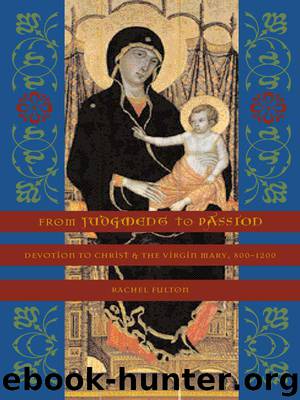From Judgment to Passion by Rachel Fulton Brown

Author:Rachel Fulton Brown [Brown, Rachel Fulton]
Language: eng
Format: epub
Tags: HIS010000, REL070000, History/Europe/General, Religion/Christianity/General
ISBN: 9780231500760
Publisher: Columbia University Press
Published: 2002-12-18T05:00:00+00:00
In other words, she began to speak. But—we are compelled by Rupert’s paradoxical reticence here to ask—why? Why did she abandon her contemplation in order to teach? And what did her experience have to do with something that had happened in Rupert’s “own day”? Clearly, something odd and, doubtless, highly significant has just happened here, but what, exactly, and why?
“My Belly Trembled at His Touch”
If it is difficult to know how to take Rupert here (as it undoubtedly is), it is even more difficult to know how to go on—nor, although it is tempting, does it seem that we should (and Rupert would seem to want us to), if, that is, we would understand the historia veiled so ambiguously in the shifting ductus of Rupert’s text. The direct address to Mary, the great parataxis of “whys,” the allusions to present-day difficulties with unbelieving Jews and with the cares of taking on the instruction of a community, and then, suddenly, inexplicably, the shift from exegetical meditation to anecdote, and just as suddenly and inexplicably, the shift back. Why, after all, interrupt the narrative ductus of the commentary with a story of events that happened “in our own day,” and why, having done so, give no explanation other than that Mary’s experience must have been “somewhat” (aliquatenus) like this, “only greater”? Why not simply imagine Mary’s response directly, as elsewhere in the commentary? Who was this “adulescentula” who “in our own day” had such erotic visions of her Lord that she found herself, when she awoke, trembling on her couch in a state of seemingly postorgasmic frisson? Rupert introduces her as if she were an actual person, much as one might introduce the story of a miracle worked by a saint at a particular shrine (“Nostra aetate referebat quaedam adulescentularum…”)—and yet, further along, he indicates that this “young woman” was, rather, a “soul,” so perhaps she was not an actual person at all but simply a reification of an interior aspect of a person. But how, then, are we to understand the emphasis on the very tactile—indeed, corporeal—nature of her experience: her trembling at the touch of the mysterious hand, her finding herself joined hand to hand, mouth to mouth, and body to body with the man on the cross? And why, after all, relate her experience as if it were analogous to Mary’s? If—I would insist—we are fully to understand Rupert’s commentary, the historia on which he structured his mystical exposition, we must be very careful here about the way in which we answer these questions, particularly the last.
The short answer, as should by now be all too obvious (and was at the time), is that Rupert was here referring to himself (“istud dicit de semetipso,” according to the marginal notation of at least one medieval reader174), that it was his heart “leaping and dancing with ineffable joy” that the Lord held in his hand, and that it was his mouth that the man on the cross kissed and whose body
Download
This site does not store any files on its server. We only index and link to content provided by other sites. Please contact the content providers to delete copyright contents if any and email us, we'll remove relevant links or contents immediately.
Resisting Happiness by Matthew Kelly(3197)
The Social Psychology of Inequality by Unknown(2770)
Designing Your Life by Bill Burnett(2605)
Day by Elie Wiesel(2596)
The Giving Tree by Shel Silverstein(2174)
Angels of God: The Bible, the Church and the Heavenly Hosts by Mike Aquilina(1870)
Human Design by Chetan Parkyn(1859)
The Supreme Gift by Paulo Coelho(1800)
Jesus of Nazareth by Joseph Ratzinger(1709)
Augustine: Conversions to Confessions by Robin Lane Fox(1688)
Hostage to the Devil by Malachi Martin(1676)
7 Secrets of Divine Mercy by Vinny Flynn(1620)
Dark Mysteries of the Vatican by H. Paul Jeffers(1607)
The Vatican Pimpernel by Brian Fleming(1588)
St. Thomas Aquinas by G. K. Chesterton(1557)
Saints & Angels by Doreen Virtue(1530)
The Ratline by Philippe Sands(1425)
My Daily Catholic Bible, NABRE by Thigpen Edited by Dr. Paul(1418)
Called to Life by Jacques Philippe(1410)
